Update (10.05.2016): The Mercury Transit is over. It was great – inspite of bad seeing
We from Team Baader Planeatrium together with our colleagues have observed the Mercury Transit and captured the Event. Unfortunately the results are not nearly as good as expected, the seeing was very bad at our location and we had to adress some problems. We still enjoyed the Transit that we started watching from the first contact – with drinks and food and many devices for observation. After about an hour most of our colleagues got back to work – its not a solar eclipse after all… We didn´t create a video of the whole transit, but you can see here a short 1min Video with a few animations and a timelapse and single images of our setup.
Original News (02.03.2016): An ideal target for observation and photography with telescopes, spotting scopes, telephoto lenses and binoculars – equipped with Baader Astrosolar Film
A little more than a year after the last solar eclipse in Europe, when the moon covered the sun almost completely, we will experience a very rare „mini eclipse“. It will be generated by Mercury, the planet closest to the sun. It is only a little bit larger than our Moon but is much further away from Earth:
| Diameter | Distance from Earth | |
| Moon | 3.474km | 384.000km |
| Mercury | 4.880km | 80.000.000km |
When Mercury moves between Sun and Earth it covers less than one-tenth of a percent of the Sun. For an observer on Earth it appears a tiny black dot, only 12 arcseconds in diameter, in front of the big solar disk. Because of this small size you cannot see the event with a “solar eclipse viewer”. You need an optical instrument (telescope, telephoto lens, spotting scope, binocular) with at least 10 – 15x magnification to enjoy the transit.
Every optical instrument that you want to use for solar observing needs to be equipped with a solar filter! (please read our safety instructions).
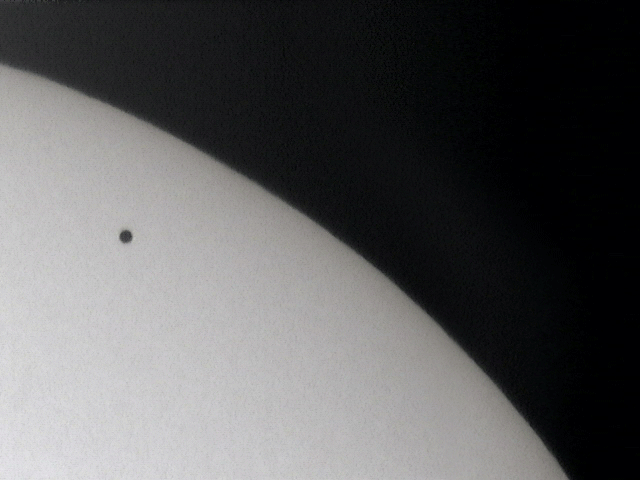
Animation of Mercury-Transit in 2003 – composed from three single images: Webcam-images at bad seeing and high magnification show Mercury as a small planet disc
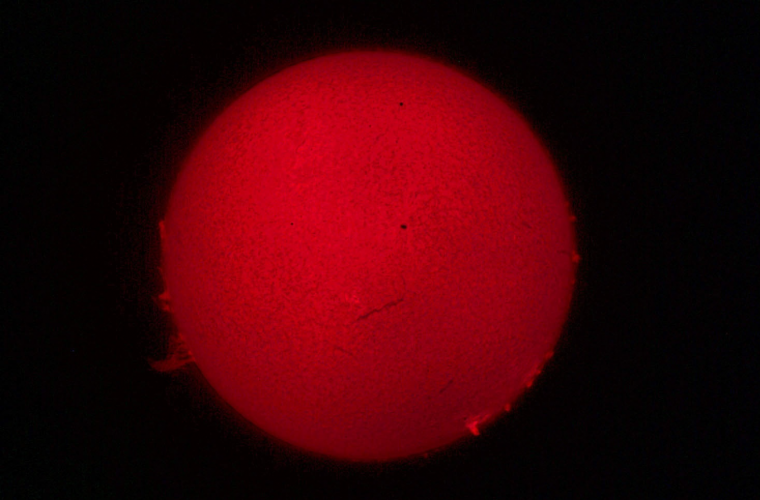
Merkur-Transit on May 7th, 2003, Image Team Baader Planetarium. Mercury is the small dark dot on top part of the sun, even smaller than the sunspot in the middle. Image taken with H-alpha Filter by SolarSpectrum, shows the eruptions (protuberances) on the surface of the sun.
What to expect, when and where
In difference to a Solar Eclipse by the moon, which can only be seen in a small strip across the Earth, the transit of Mercury can be seen in all regions of our planet were the sun is over the horizon during the time of the event. The map of NASA shows exactly were this will be.
The chances in Europe are quite high, in northern parts of the continent even in full length (7h30min) while in more southern regions the sun will sink below the horizon before Mercury leaves the solar disc. Times in the maps are given in UT (Universal Time). Middle European summer time (MESZ) = UT+2h.
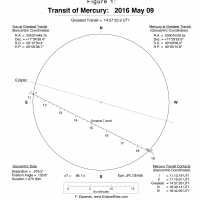 13.12h MESZ: Transit starts, the black disc of Mercury moves over the limb of the solar disc
13.12h MESZ: Transit starts, the black disc of Mercury moves over the limb of the solar disc
16.57h MESZ: Halftime of the event
20.42 MESZ: The planet leaves the sun
How to observe the event?
Some observers of the 2003 Mercury transit were able to see the event with only 10x magnifying binoculars. But this will not be the best option, Mercury is only a tiny black dot and very hard to see with such a low magnification. We recommend at least 15x magnification, the real fun starts at around 50x – then Mercury is not only a black dot but a small disc. Then you will see the size difference to the sun and get a feeling for the solar system – you will see a real planet moving in real time, real size, this is quite fascinating.

On www.celestron-deutschland.de we offer several bundles for safe solar observation with Celestron 6″, 8″, 9¼” or 11″ telescopes.
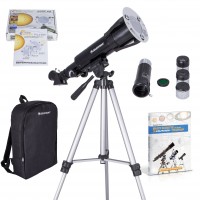
Observe the transit – with TravelScope 60 “Solar System Edition”
Recommended products from
www.celestron-deutschland.de:
Do you already own a telescope? Please take a look at the four bundles with Q-Turret and 4pc eyepiece set and barlow lens for up to 8 magnifications and ASTF Solar Filter for 6″, 8″, 9¼” or 11″ telescopes. You can order the bundles on www.celestron-deutschland.de
You don´t have a telescope? Then this offer is for you: TravelScope 60 “Solar System Edition”
Do you want to take photos of the event? This is possible with every camera that magnifies the solar image enough to make the tiny black dot of Mercury visible. If you own a DSLR, every telephoto lens with a focal length of 200mm or more should work; but also bridge- or system-cameras with good zoom lenses should work. Please have a look here to find the right solar filter for your camera: Baader Solar Filter Finder-Tool
When will the next Mercury transit occur?

The orbits of Mercury and Earth | Source: Wikipedia
Mercury orbits the sun once every 88 days. You might think that there must be four Mercury transits every year but this is not the case because Earth is also moving around the sun so that these both planets are meeting only once every 108-130 days in a way that a transit would be possible. Furthermore the orbits of both planets are inclined about 7 degrees to each other. That means that there are only two dates during Earth orbit, one in May and one in November, when Mercury and Earth can be aligned in a way that Mercury transits the sun. Only when Mercury is at one of these “crosspoints” of their orbits at the same time as the Earth, a transit will occur. This happens rarely compared with Solar Eclipses and Moon Eclipses, but quite regulary. There is usually a set of two transits only 3 years apart from each other every 10-13 years. Here is a complete list: http://eclipse.gsfc.nasa.gov/transit/catalog/MercuryCatalog.html
The two last transits happened in 2003 and 2006. The transit of this year (2016) and the transit 2019 form another pair. Then it takes until 2032 before the next transit happens, and then again until 2039. So when you miss the transit this year you will have another chance in 3 years and later on. Have fun!

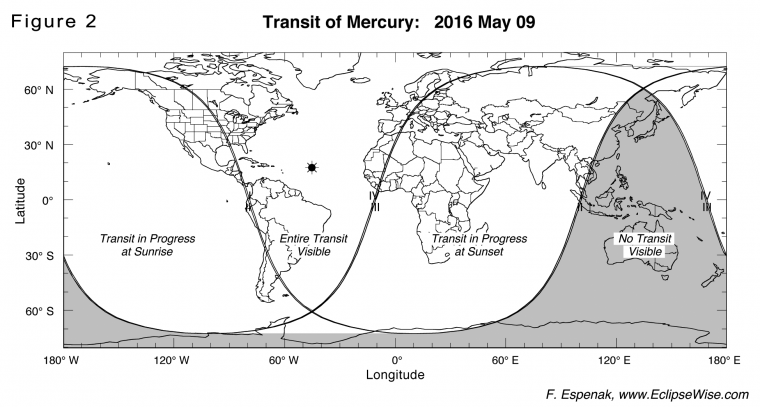
Mercury across the Sun’s disk and the scale gives the Universal Time of Mercury’s position at any instant during the transit.
I used your solar filter for the last transit of Venus and i’m looking forward to using it for this next transit of Mercury!